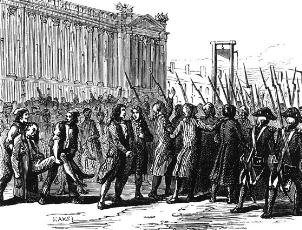
Go Back


The Title "Citizen"
With the abolition of the monarchy, the French also do away with honorific titles like "Mr.", "Mrs." (or in French, "monsieur" or "madame") or "Your Highness." Everyone is equal, men and women. The title "Citizen" comes to be used before the surname, so in The Scarlet Pimpernel, Chauvelin is introduced as "Citizen Chauvelin." After the Russian Revolution of 1917, Russians began a similar practice by calling everyone "comrade."
1791: In June, sensing that their time is running out, the Royal Family tries to escape from France. They disguise themselves as the servants of a German noblewoman. The King is recognized and the alarm is raised. The National Guard halts the coach and the King and Queen are returned to Paris. As a newspaper reported, "This was no triumphal procession, it was the prison convoy of the monarchy!" (from Cobb and Jones, "Voices of the Monarchy")
The moderates push through their constitutional monarchy. On September 14, 1791, the King, weak and defeated, swears to uphold the new constitution.
As 1792 begins, a new group of moderates came into power. Led by Jacques Brissot, who came from a province near the River Gironde, the group became known as the Girondists. The problems that had occurred under Louis had not gone away - food shortages and high taxes continue to plague a discontented populace.
Tensions continue to rise: the people of Paris became more and more frustrated with their government. The poor begin to call themselves "sans-culottes," meaning "without knee-breeches," which were seen to be a symbol of the nobility.
In August (another hot summer!), the sans-culottes give the Assembly a choice: depose the King or turn him over to the mob. Under pressure from the Commune, the Assembly imprisons the Royal Family, where they await trial with great apprehension. As the summer ends, a new device is unveiled in front of the Tuileries. It has a tall frame, with a large heavy blade fit into a wooden groove. It is the guillotine.
Madame Guillotine
"Now gaze on our goddess of justice with her shimmering, glimmering blade as she kisses these traitors she sings them a last seranade!"
It was called "the hot hand," "the widow," "the machine," "the blade of the law," "the national razor." Named after its inventor, Joseph Ignace Guillotin (1738-1814), the guillotine became a symbol of the bloodthirsty terror of the French Revolution. Ironically, Guillotin originally created the device as a humane form of execution, a painless and quick substitute for the clumsy axe or noose. "The mechanism falls like thunder," he said, "The head flies off, blood spurts, the man is no more." As the guillotine became more and more popular, Dr. Guillotin came to hate his creation. You might be surprised to learn that the guillotine was used in executions until 1977 when a Tunisian murderer was the last to be beheaded in France. In 1981, capital punishment was outlawed in France.

The people, represented by the Commune, now rule over Paris. Police are
given the power to search homes without warrant and arrest anyone without
charge. Paranoia and fear sweep Paris. In a speech, Danton speaks of the
enemies of France plotting her downfall while in prison. Mobs move from
prison to prison, killing prisoners after only a few minutes of
questioning. This became known as the "September Massacres" -
1,400 people are killed.
On September 21st, the new National Convention abolishes the Monarchy completely and declares France a Republic.
With the Monarchy gone, what to do with the Monarch? On December 11th, Louis XVI is brought before the assembly to face charges of treason against France. He is questioned for 3 hours. Although he faces his accusers with dignity, he is indicted on 33 counts of treason. As the New Year begins, the Convention votes to execute the King.
1793: January 21st - A horse drawn coach takes Louis to the Place de la Revolution, where 20,000 people gather. Standing on the platform, he says "My people. I die innocent of all the crimes of which I have been charged. I pardon those who have brought about my death and I pray that the blood you are about to shed may never be required of France..." (as quoted in "Citizens" by Simon Schama) As the executioner raises Louis' head, the crowd cheers wildly.
Revolted by the Revolution
The Scarlet Pimpernel was not alone - disgust against the French Revolution grows all over Europe.
Like Dickens' famous novel, The Scarlet Pimpernel is a "tale of two cities," with the English point of view as important as the French. After Louis' execution, The London Times writes, "Are these the 'Rights of Man?' Is this the liberty of Human nature? The most savage four footed tyrants that range the unexplored deserts of Africa in point of tenderness, rise superior to these two-legged Parisian animals." British Prime Minister William Pitt calls it "the foulest and most atrocious act the world has ever seen."Although he had supported the rights of the American colonists to secede from Britain, the British statesman Edmund Burke writes a scathing criticism of the French Revolution, calling its bloody actions in the name of freedom nothing more than a new form of tyranny. In his 1790 book "Reflections on the Revolution in France," he writes, "When ancient opinions and rules of life are taken away, the loss cannot be estimated. From that moment we have no compass to govern us."
Many, like the Scarlet Pimpernel, try to secretly save the lives of the innocent. United States Envoy Gouverneur Morris gave many aristocrats sanctuary and safe passage to the U.S.
Website Copyright Policy